Day 2 :
Keynote Forum
Ana Barros-Timmons
University of Aveiro, Portugal
Keynote: Encapsulation and immobilization of copolymer @ Au NP’s in thin films for biosensing applications
Time : 09:55-10:40

Biography:
Ana Barros Timmons has completed her PhD in Chemistry in 1997 from Manchester University. Since 1996 she has been lecturing at the University of Aveiro various courses related to Polymer Science and Chemical Engineering laboratories as well as participating in the coordination of a couple of joint European Master Courses in the field of Materials Science & Enginnering. She has published ca 70 papers in reputed journals and over 120 communications. Her research interests are foccused on the preparation and characterization of nanocomposite materials with particular emphasis on controlled polymerization mechanisms, thermal analyses and the use of renewable materials
Abstract:
Gold nanoparticles (Au NP’s) have been highly explored in biosensing applications due to their unique optical properties. However surface modification and functionalization are required in order to obtain functional and stable Au NP’s in physiological medium. In turn, the use of reversible addition-fragmentation chain transfer (RAFT) polymerization offers the possibility of full control over the composition and architecture of polymeric shells and allows further biofunctionalization for specific bio targeting. Moreover, the immobilization of Au NP’s in organized thin films is important to build biosensing devices. The Layer-by-Layer (LbL) technique is very promising for the preparation of such thin films since it is a scalable, easy and versatile technique.
In this work, Au NP’s were functionalized via RAFT-assisted encapsulating emulsion polymerization (REEP) and click chemistry. First, a macroRAFT (MR) agent based on poly(ethylene glycol) methyl ether acrylate (PEGA) and containing an azide function was adsorbed onto Au NP’s (d=15 nm) to afford MR@Au NP’s. Then a hydrophobic chain was growth from the MR@Au NP’s surface via REEP to yield copolymer@Au NP’s - shell@core type structures. The functionalized copolymer@Au NPs were obtained via click chemistry using an alkylated biotin. Visible spectroscopy has shown that these functionalized Au nanostructures are promising towards biosensing application, namely in the detection of the specific biotarget – avidin.
Additionally, the interactions at molecular level between the block copolymer prepared under the same reaction conditions, were briefly studied using the Langmuir-Blodgett technique. Finally, thin films were prepared via LbL technique using the negative copolymer@Au NP’s and the polycation poly(allylamine hydrochloride). The biosensing response of these films was assessed by optical spectroscopy using the avidin and bovine serum albumin as specific analyte and control, respectively. The results obtained have shown that REEP is a promising strategy to prepare robust functional plasmonic nanostructures towards biosensing application
Keynote Forum
Richard J. Spontak
North Carolina State University, USA
Keynote: Morphological development & versatile properties of charged thermoplastic elastomers
Time : 10:40-11:25

Biography:
Richard J. Spontak, Distinguished Professor and Alumni Distinguished Professor at NC State University and Lars Onsager Professor Emeritus at the Norwegian University of Science & Technology, investigates the phase behavior and functional/responsive properties of block copolymers/ ionomers, as well as network-forming materials and hybrid nanocomposites. He has over 290 peer-reviewed scholarly publications, and his work has been featured on 26 journal covers and cited over 10,000 times. In recognition of his research, he has received numerous honors such as the 2006 ACS Cooperative Research Award in Polymer Science, the 2007 German Society for Electron Microscopy Ernst Ruska Prize, the 2008 ACS Chemistry of Thermoplastic Elastomers Award, the 2011 Institute of Materials, Minerals and Mining (IOM3) Colwyn Medal, and the 2015 SPE International Award. An elected fellow of the American Physical Society, IOM3 and the Royal Society of Chemistry, he is also a member of the Norwegian Academy of Technological Sciences.
Abstract:
Block copolymers continue to capture the attention of the academic and industrial worlds due to their fascinating ability to self-assemble into a wide variety of "soft" nanostructures that are ideally suited for a broad range of diverse nanotechnologies. The development of thermoplastic elastomers (TPEs) also endows these materials with elastic network-forming characteristics In the presence of a midblock-selective solvent, these materials form TPE gels (TPEGs) with remarkable mechanical properties. While most TPEs are inherently nonpolar, targeted functionalization can permit these materials to be used in the presence of polar environments. Sulfonation of TPEs, for example, yields materials that possess amphiphilic properties for new applications. We have recently demonstrated that these materials are competitive candidates for electroresponsive media, amphoteric gas-separation membranes and organic photovoltaics. Unfortunately, the inherently high thermodynamic incompatibilities and glass transition temperatures of such materials effectively prevent the use of thermal annealing, routinely employed to refine the morphologies of nonionic block copolymers. An alternative athermal approach is required to control morphological development in charged TPEs. This presentation explores the morphological characteristics of midblock-sulfonated TPEs differing in their degree of sulfonation and templated from solvents varying in polarity, followed by several different solvent-vapor processes: annealing, permeation and sorption. Electron microscopy and synchrotron scattering confirm that films prepared from different solvents form nonequilibrium morphologies due to solvent-templated self-assembly and drying. Exposing cast films to the vapor of a polar solvent constitutes an effective post-equilibration protocol. Judicious solvent exposure likewise improves nanostructure orientation. In addition to solvent-related processes, discrete ion-rich microdomains are found to undergo an irreversible phase transformation and become continuous due to hydrothermal treatment, thereby causing these materials to become superabsorbent.
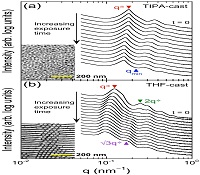
Figure: Time-resolved SAXS profiles and TEM images of charged TPEs templated from different solvents — (a) toluene/isopropanol (TIPA) and (b) tetrahydrofuran (THF) — and subjected to hydrothermal annealing at 25°C.
Networking & Refreshment Break 11:25-11:40 @ Foyer
Keynote Forum
Nekane Guarrotxena
Spanish National Research Council (CSIC), Spain
Keynote: Engineering “smart†nanohybrid materials: New polymeric strategies for NPs functionalization and their improved applications
Time : 11:40-12:25

Biography:
Nekane Guarrotxena is a PhD from the University of Complutense, Madrid-Spain and was a Post-doctoral Research at the Ecole Nationale Superieure d´Arts et Metiers (ENSAM), Paris-France and the University of Science II, Montpellier-France. She was the Vice-Director of the Institute of Polymer Science and Technology (ICTP-CSIC) (2001-2005) and Visiting Professor at University of California, Santa Barbara-USA and the CaSTL at University of California, Irvine-USA (2008-2011). She is currently the Research Scientist at ICTP-CSIC (Spain), Editorial Board Member of some Materials Science and Chemistry journals and External Expertise Consultant on I+D+I management Policy for National and International Agencies. Her research interest focuses on the synthesis and assembly of hybrid nanomaterials, nanoplasmonics, and their uses in nanobiotechnology applications (bio-imaging, drug delivery, therapy and bio-sensing).
Abstract:
The field of functional nanohybrid or nanocomposite materials is one of the most promising and rapidly emerging research areas in materials chemistry. These materials can be defined as synthetic organic-inorganic materials linked together at nanometer scale. The huge potential combinations of the distinct properties of inorganic and organic components in a single material have attracted considerable attention; and provide vast opportunities to develop novel advanced materials with well-controlled structures and multiple functions. On the one hand, the morphology- dependent tunable magnetic, optical, and electronic properties of inorganic nanoparticles (NPs) can be advantageous to many fields, such as optical and electronic materials, biomaterials, catalysis, sensing, coating, and energy storage. On the other hand, a smart-polymer is a high performance polymer which shows sensitiveness to temperature, humidity, stress, pH or an electrical/magnetic field and respond varying colour or transparency, becoming conductive or permeable to water, among other ways. Interestingly, in these materials slight changes in the environment induce large changes in the polymer´s properties; and consequently, the combination inorganic nanoparticles-stimuli-response polymers yields smart nanohybrids and nanocomposites with improved and even novel properties. However, despite the breadth of papers attesting the interest of the subject, the establishment of new and simple protocols for polymer-coating of inorganic NPs still remains a challenge. In fact, polymer-stabilized NPs in organic solvents offer a great chemical playground for directed self-assembly, by simply changing the composition of the solvent; which expands their potential applications. In this talk, we will highlight our recent development in the area of multifunctional organic-inorganic hybrid nanostructures, laying focus on the improved, optical and electronic properties of organic-inorganic nanomaterials as a response to chemical signals conversions derived from the impact of pH and temperature external stimuli. This research requires a good understanding of structure-property relationships that guide to new materials.
- Polymer Nanotechnology | Polymer Chemistry | Composite Polymeric Materials
Location: London

Chair
Nekane Guarrotxena
Spanish National Research Council (CSIC), Spain
Session Introduction
Ebru Basaran
Anadolu University, Turkey
Title: Polymeric nanoparticles for antifungal ocular theraphy
Time : 12:25-13:00

Biography:
Dr. Ebru BaÅŸaran has completed her PhD study with the thesis entitled “Formulation and In Vitro - In Vivo Evaluation of Cyclosporine A Incorporated Solid Lipid Nanoparticles, Microemulsion and Polymeric Nanoparticles Aiming Ocular Application” at the Anadolu University Faculty of Pharmacy at Pharmaceutical Technology Department in 2007. The doctorate study was awarded by NAGAI Foundation as the “Best Research Work” at FAPA meeting in 2008. She focused on formulation and characterization of nano-microparticulate delivery systems for ocular application. Currently Dr. BaÅŸaran is working as an Assoc. Prof. at the Anadolu University Faculty of Pharmacy Department of Pharmaceutical Technology since 2017.
Abstract:
Voriconazole (VOR) is a triazole antifungal derived from fluconazole is very active against various fungi including those resistant to fluconazole.1 Treatment of ocular fungal infections remains problematic because of the relatively short list of available therapeutic agents.2 Limited ocular bioavailability of active agents due to the characteristic properties of the eye also limits the efficacy of the treatment. Therefore main approaches for the enhancement of ocular bioavailability of the formulations applied are enhancement of the residence time of the active material at the site of action or enhancement of the ocular penetration of the primary penetration site.
MATERIALS and METHODS
Voriconazole was kindly gifted by Deva Holding (Çerkezköy, TekirdaÄŸ), Eudragit® RS 100 was purchased from Röhm Pharma Polymers (Darmstadt, Germany) and methanol was from Merck (Darmstadt, Germany). All other chemicals used were analytical grade.
FORMULATION OF POLYMERIC NANOPARTICLES
Spray drying method (Büchi B-190, BÜCHI Labortechnik AG, Switzerland) was used for the preparation of polymer based nanoparticles.4 Compositions of the selected formulations were given in Table 1.
CHARACTERIZATION STUDIES OF POLYMERIC NANOPARTICLES
SEM, particle size, polydispersity index, zeta potential analyses were performed. In order to evaluate changes of the polymeric structure DSC analyses were also performed. A validated HPLC method was used for the determination of incorporated PTX.
RESULTS and DISCUSSION
Morphological analyses showed that particles are round in shape (Figure 1).
Particle size, polydispersity index, zeta potential analyses with incorporated VOR amount of the formulations were given in Table 2.
Analyses results revealed that the particle sizes were in the nanometer range with homogenous size distribution (Table 2) with no changes in the polymeric structure (Fig. 2).
CONCLUSION
As a conclusion VOR incorporated polymeric nanoparticles were successfully formulated by spray drying method aiming efficient treatment of ocular fungal infections. In vitro and in vivo efficacy of the formulations will be studied as the second part of the study.
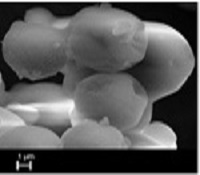
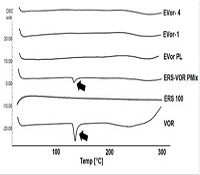
Figure: SEM image of polymeric spheres Figure: DSC analyses of the formulations prepared
Lunch Break 13:00-13:55 @ Athens
M V N Ambika prasad
Gulbarga University, India
Title: Studies of conducting polymers nanocomposites and its applications
Time : 13:55-14:30

Biography:
M V N Ambika Prasad has received MSc degree in Physics from Osmania University, Hyderabad and PhD in Physics from Indian Institute of Technology (IIT), New Delhi. He is currently a Professor of Physics at Gulbarga University, Gulbarga. His research interest includes conducting polymer and nanocomposites, understanding the electrical and thermal behaviour of the materials at nano size and sensing behaviors of various conducting polymers exposed to gas and humidity.
Abstract:
The Polyaniline (PANI) has emerged as one of the most promising conducting polymers, because of its wide spread applications and due to the combination of unique properties like simple preparation and doping procedure, good environmental stability, relatively high conductivity and low cost. The inorganic–organic composites containing polymer as the organic base and Gallium oxide, Vanadium Pentoxide and Indium oxide as inorganic part have been used for studying its gas sensing. These composites have been synthesized by insitu deposition technique by placing fine grade Ga2O3, In2O3 and V2O5 in polymerization mixture of aniline. The results are well supported by FTIR spectra, SEM, XRD and Conductivity measurements. High temperature, conductivity measurements show thermal activated behavior. It is observed that electrical resistance increases with an increase in the temperature. In case of PANI-V2O5,PANI-In2O3 and PANI-Ga2O3 composites both the PANI sensing mechanism of swelling and sensing mechanism of surface charge are responsible for variation of resistance within the sensing material. Therefore, it is observed that PANI-V2O5,PANI-In2O3 and PANI-Ga2O3 composites to be a competent sensing material for LPG and this may be due to formation of surface charge and presence of capillary pores. Similar behavior for the Polymer / Nano metal oxide composites such has Polyaniline-Tungsten oxide, Polyaniline-Cobalt oxide and Polyaniline- Cerium oxide have been observed for its humidity and Gas sensing. Similarly,conducting polymers have found to have applications in Biology in Bio sensors,anti bacterial action, pigeon pea plant growth, microwave absorbers etc.
Yi Luo
Dalian University of Technology, China
Title: Origins of selectivity and activity of olefi n polymerization catalyzed by rare earth metal complexes
Time : 14:30-15:05

Biography:
Yi Luo received his PhD degree in Material Chemistry from Tohoku University in 2004, supervised by Prof. Akira Miyamoto. He has his expertise in computational organometallic chemistry. In the field of computational chemistry, his research interests include rare-earth metal catalyzed polymerizations. He has also contributed good works on intermetallic cooperation towards activation of chemical bond, including C=C double bond. He is active in his scientific research and often collaborates with experimentalists to discover new chemistry together. The effect of THF molecule on olefin polymerization catalyzed by rare earth metal complexes, which was a long-term concern in this field, have been clarified in his multiple research works. It has been proposed that, at the molecular level, the generation of catalytically active species and its chemical hardness could account for the polymerization activity.
Abstract:
Rare-earth metal complexes as a kind of polymerization catalyst usually show unique polymerization activity and selectivity and therefore afford various microstructures of the resulting polymers, not achievable via. transition metal analogues. Mechanism-based rational design of catalyst provides an attractive way towards new polymer materials with desired properties. In this context, theoretical calculations can help in many ways. Charactering catalytic active species, clarifying the mechanism behind experimental phenomenon, and dynamic modeling of polymerization process are just a few examples. With an increase in computer technology and more robust algorithms, computational chemistry has become a viable option for molecular studies in the field of polymer chemistry. In this talk, computational investigations on the molecular mechanism of polymerization catalyzed by rare-earth metal complexes will be introduced. The polymerization mechanisms of conjugated dienes, styrene, and 1-hexene will be covered in the presentation. Especially, the origins of experimentally observed regio- and stereo-selectivity as well as activity suggested by theoretical calculations will be discussed. The polymerization mechanism of lactone and vinyl polar monomers will be also included.
Saul Sanchez-Valdés
Applied Chemistry Research Center (CIQA), Mexico
Title: Photo-stability of low-density polyethylene and ethylene vinyl acetate blends with nanoclay: Towards durable nanocomposites for agricultural fi lms
Time : 15:05-15:40

Biography:
Saul Sanchez has him expertise in preparation and characterization of polymer nanomaterials. He is a senior researcher at Applied Chemistry Research Center (CIQA) for more than 29 years. He received his PhD in Materials Engineering from the UANL in Mexico. He has published more than 70 technical papers, 6 patents and 3 books related with polymer material science, and has supervised more than 20 MSc and PhD thesis. His research work at CIQA has been related most with: polymer processing, polymer nanocomposite materials, polymer functionalization and characterization.
Abstract:
Polyethylene / ethylene vinyl acetate films are prepared and characterized in the presence of three different organo-modified clays. Two organo-modified clays, C20A and I28E, with different type of surfactant, in terms of polarity and number of tallows, is analyzed. The influence of clay organo-modifier on film morphology, mechanical and photo-oxidative degradation performance is studied. As well as the effect of the incorporation of a maleic anhydride grafted Polyethylene (PEgMA) as compatibilizer. The combined effect of these clays with two different UV-oxidative protection systems for PE/EVA nanostructured films is evaluated. Two types of UV stabilizer combination systems is used. One, designed as MB-A with a heat and light stabilizers of blends of antioxidants (phenolic and metal deactivator, Irgatec NC66) with hindered amines, Tinuvin 494AR and other, designed as MB-B with blends of metal deactivator antioxidant, Irganox MD1024 with hindered amines Tinuvin NOR 371 and benzophenones, Chimasorb 81. A strong influence is observed in the use of compatibilizing agent, type and content of nanoclay in the degree of dispersion as well as in the photo-oxidation behavior. The structure obtained is very dependent on the modified clay used; mostly, intercalated-exfoliated structure is produced. These films can be an attractive option for agricultural greenhouse cover films since the clay enhance the greenhouse effect reducing the passage of infrared radiation from the soil during the night maintaining warmer the film covered atmosphere.
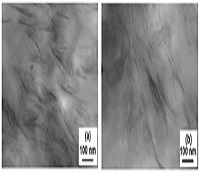
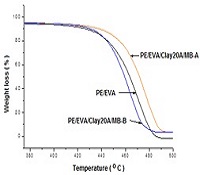

Figure: STEM images of: (a) PE/EVA/C20A (b) PE/EVA/I28E Figure: TGA of PE/EVA/Clay with two types of UV stabilizers Figure: Elongation change with time of photo-oxidation
Sara P Magalhães da Silva
Aveiro Institute of Materials, Portugal
Title: Green composites based on cork residues for additive manufacturing
Time : 16:00-16:25
Biography:
Sara P. Magalhães da Silva has a Master in Chemical Engineering and she is a PhD student of Materials Science and Engineering at University of Aveiro, Portugal. Her field of research is related to the development and characterization of thermoplastic composites for injection molding applications; development of new materials formulations for additive manufacturing; lignocellulosic residues valorization. This work is part of her PhD thesis entitled “Cork-polymer composites – A sustainable solution in injection molding and additive manufacturing”.
Abstract:
Statement of the Problem: An important stage of materials development is the validation of its mechanical performance prior to the manufacturing step. In composite materials, mechanical properties are highly dependent on the interaction between polymer matrix and the filler1-3. Cork-polymer composites (CPC) based on biodegradable matrices for fused filament fabrication (FFF) technique were prepared. FFF, an additive manufacturing (AM), is an extrusion-based technique, in which a thermoplastic filament is melted and selectively extruded via nozzle, deposited layer by layer4. Cork is the outer bark of Quercus Suber L. oak tree and possesses an unique combination of properties: low density, viscoelasticity, high recovery capacity after impact, among others5. Biodegradable polymers as neat polylactic acid (PLA) and PLA/Polyhydroxyalkanoate (PHA) blend were used as matrices in composites formulation. The selection of an elastomeric blend, PLA/PHA, was based on the compatibility of the elastic behavior of cork and to print a more flexible product. In order to evaluate the adhesion between cork and the polymeric matrices, morphological, chemical and mechanical analyses were performed.
Methodology: CPC were prepared using cork powder residues from industrial stoppers production. Both PLA/PHA blend and CPC were prepared by melt compounding. Morphological analyses were made by scanning electron microscopy (SEM); chemical analyses by Fourier Transform Infra-Red (FTIR); and, mechanical tests (tensile, flexural and impact).
Findings: Morphological and chemical analyses revealed a good adhesion of cork to the biodegradable matrices. When cork was incorporated in neat PLA, led to a more flexible material. Conclusion: The incorporation of cork powder residues into biodegradable matrices results on the development of sustainable green composites. AM techniques can add value to these green composites by employing them as filaments for FFF. Combining FFF with the unique cork properties and aesthetics, can potential new design freedom solutions and products.
Padmaja Guggilla
Alabama A&M University, USA
Title: Reducing the bandgap energy via doping process in lead-free thin fi lm nanocomposites
Time : 16:25-17:00

Biography:
Padmaja Guggilla has completed her PhD from Alabama A&M University in 2007. She is presently working as Associate Professor of Physics at Alabama A&M University. She has published more than 45 papers in reputed journals and has been serving as an Editorial Board Member of reputed journals. She has secured over 2 million dollars of extramural funds as Principal Investigator in the last five years
Abstract:
There are numerous applications for the pyroelectric composite films in the medical field, military field and environmental applications field. The main focus of this research is to fabricate the higher efficiency thin films that are flexible like the polymers. PVDF is ideal when it comes to making detectors as they are flexible; possess high pyroelectric current and resistance, low dielectric constant and density. Pure PVDF and PVDF films doped with CNT and MWCNT, PVDF: LiTaO3, PVDF:LiTaO3 films doped with MWCNT thin films were fabricated using the solution casting technique. Evaluated the deposited films’ electrical, optical and structural properties using SEM, FTIR Spectroscopy, UV-Vis Spectroscopy, and Raman Spectrum. Results show that doping with CNT and MWCNT is enhancing the key characteristics that are beneficial for the optical devices industry.
Usman Yaqoob
University of Ulsan, Republic of Korea
Title: Synthesis of high dielectric constant fl exible piezoelectric sheet using P(VDF-TrFE)-BTO-rGO composite and its application to energy harvesting
Time : 17:00-17:25

Biography:
Usman Yaqoob received his B.Sc. from the School of Electronics Engineering, International Islamic University Islamabad, Islamabad, Pakistan, in 2013. He is now working as a Ph.D. candidature in the School of Electrical Engineering, University of Ulsan, Ulsan, South Korea. His research interests include WO3, CNTs, graphene based flexible nanosensors and flexible piezoelectric nanogenerators.
Abstract:
Piezoelectric materials have attracted considerable attention due to their ability to scavenge electrical energy directly from ambient mechanical sources. The energy harvesting from these materials can be a promising way to phase out conventional batteries and power cables. Over the past few decades, considerable efforts have been made to develop a flexible piezoelectric material that possesses high dielectric constant and high breakdown strength by combining polymer-ceramic composites. However, high amount of ceramic filer (>50 vol%.) is required to obtain the maximum dielectric constant (k) from the composite material which can reduce the mechanical flexibility of the composite film. To address this matter, and for further enhancement in k value, a possible solution is to employ a conductive filler. The introduction of conductive filler will not only elevate the dielectric constant by forming several micro-capacitors inside the composite but will also assist in the stabilization of the polar beta (β) phase of the P(VDF-TrFE). The polar β phase of polymer is highly required to obtain maximum energy harvesting properties. Herein, we presents the synthesis and optimization of flexible piezoelectric materials based on poly(vinylidenefluoride)-reduced graphene oxide-barium titanate (PVDF-RGO-BTO) for its application in energy harvesting. To obtain the maximum dielectric constant, different compositions have been prepared by varying the reduced graphene oxide (RGO) contents in the PVDF-BTO nanocomposition. The sample with 5wt% RGO contents (PRB5) has revealed maximum dielectric constant of 170 at 1 kHz. Therefore, has been selected to fabricate the piezoelectric nanogenerator (PENG). The fabricated PENG exhibits maximum open circuit voltage of 4 V(pk-pk) and short-circuit current of 1.5 μA(pk-pk) at an applied force of 2N. Additionally, the maximum output power for the fabricated PENG was recorded around 3.8 μW at 1 MΩ load resistance. It was estimated that fabricated PENG can be a promising energy source for futuristic flexible electronics.

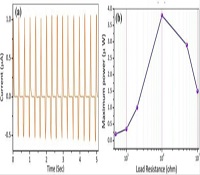
Closing Cermony
